11
Editing to Structure a Reader's Experience
"A thing is unified and clear and simple because it is designed that way, or it is not unified and clear and simple. Making things clear and simple is hard."
[Ted Nelson, 1987]
"It is easy to think that, because learners can move through a body of knowledge
in new ways, we know where they are going."
[Michael Joyce, 1988]
Since the invention of writing, authors have explored ways to structure knowledge so their readers could extract it from linear print media. Authors have even explored strategies that enable readers to link related fragments of printed text and graphics despite their linear format.
"There are basically two difficulties in writing sequential text: deciding on sequence … and deciding what's in and what's out. [Hypertext authors] no longer have to decide what's in and what's out, but simply where to put things in the searchable maze." [Nelson, 1987]
The real-life process of creating hypertexts, however, is not that simple. The ease with which readers use and comprehend hypertext and even their ability to locate information, depend upon the structure of the hypertext network-Nelson's searchable maze. Thus, there is a great need to study how knowledge must be organized so that readers can take advantage of hypertext environments [Yankelovich, Meyrowitz and Van Dam, 1985; Conklin, 1987; Marchionini and Shneiderman, 1988].
While some hypertext/hypermedia proponents advocate total browsing freedom, experience has convinced others that too much of a good thing can be a problem. Based on experience with increasingly ambitious projects, researchers and designers are moving ahead rapidly in developing appropriate guidelines for structuring hypertexts. This chapter reports on the authors' experiences and offers specific guidance.
Our starting point in designing hypertext is to ask the question "is this knowledge base suitable for hypertext implementation or is it better implemented using conventional printed papertext?" Papertext can have several advantages over current implementations of computer-based hypertext. For example, the printed page is an excellent high-resolution display, capable of presenting large quantities of text with color graphics. It is easy to access, convenient to annotate and usually (but not always) portable. Hypertext, on the other hand, offers rapid dissemination, potentially lowered production costs, protection against information overload, possible lower cost, and true multimedia (including animation, speech, audio and full-motion video).
Central to hypertext, however, is the notion that the knowledge base is organized into a network of related elements. This central idea, leads us to test each knowledge base against the "Golden Rules of Hypertext." In our experience, knowledge bases which match the Golden Rules, are most appropriate for hypertext implementation. The rules state that:
- There is a large body of information organized into numerous fragments
- The fragments relate to each other
- The reader needs only a small fraction at any time
With these as our guiding principles, we are now ready to consider structuring techniques for hypertexts.
Author's Goals In Structuring a Hypertext
Authors of hypertexts should keep the following goals in mind:
- To improve information accessibility
- To enhance usability
- To increase reader satisfaction [Glushko, 1989]
"There are tricky problems here. One of the greatest is how to make the reader feel comfortable and oriented," warned Ted Nelson [Nelson, 1987]. The author's challenge is to structure the hypertext so that it corresponds to the ways that readers might think about the topics and to help readers create appropriate mental models of the knowledge base. To do this successfully requires an understanding of the many ways in which concepts may be tackled by readers. Such understanding is more likely to come to an author who has prior experience explaining the subject matter to engaged students.
Conflict between Physical and Logical Structure
A hypertext really has two sets of structures:
- The logical structure of a hypertext is imposed by the author. This includes the relationship between links in the database (tree, network, graph), the relationship of links to nodes and the content and design of individual nodes and networks of nodes.
- Authors usually have much less freedom when it comes time to define the physical structure of a hypertext. Layout, typography, user input device, and other aesthetic concerns are always heavily influenced by the hypertext delivery platform and development system.
In most cases, the author can rework the logical structure of the hypertext but he or she can't ignore the size and resolution of the screen onto which that logical structure will be mapped. For example, if the hypertext will be displayed on a black and white, 80 column by 25 row monitor, and the author has decided that the logical structure of the hypertext will allow 100-line long nodes, readers will have to navigate between 4 different screens within the same node. Thus, the author of a hypertext must design the logical structure keeping possible physical configurations of both the development and delivery systems in mind [Glushko, 1989].
Description of Hyperties
Much of the work described in this chapter has revolved around a hypertext system called Hyperties®, an acronym for Hypertext Interactive Encyclopedia System. Hyperties was originally a research project at the University of Maryland's Human Computer Interaction Laboratory. Cognetics Corporation (Princeton Junction, New Jersey) now distributes it commercially and has continued its development while the University of Maryland has focused its research on advanced versions.
As might be guessed from its name, Hyperties is built around the metaphor of an electronic book. This contrasts with the "stack" metaphor used by some other systems such as Hypercard. The nodes in Hyperties are called articles; they may consist of many pages. Articles may include text, graphics, audio and video. Hyperties facilitates the construction of such book-like structures as a cover, table of contents, index, footnotes, running heads and preface.
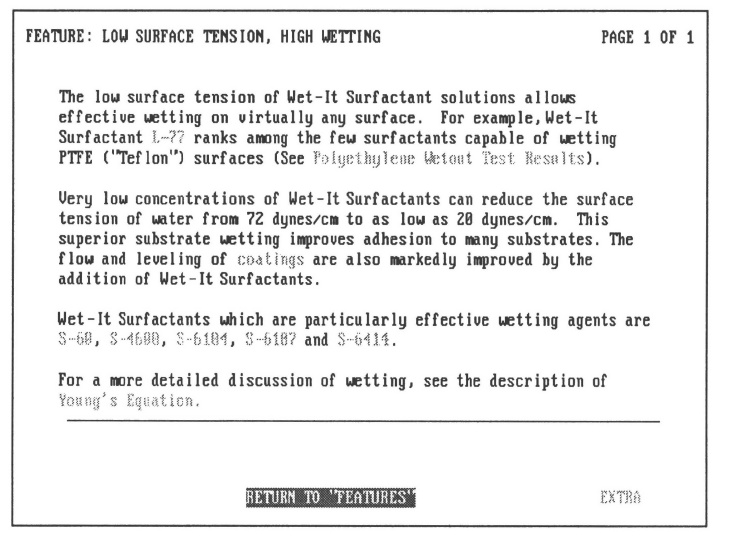
The look and feel of the electronic book can be controlled by stylesheets which specify screen layout, typefaces and "buttons." All of these elements are optional, allowing considerable flexibility in authoring hypertext. (See Figure 11.1.)
Hyperties is being used in a number of corporate settings and, at HCIL, in regular experimental studies to test design alternatives and observe user behavior. In addition, we have modified Hyperties over the years to provide the functionality and user interface features our experience has shown necessary.
This chapter outlines some of the authoring techniques we have found most effective in designing the logical structure of a hypertext database so that readers feel "comfortable and oriented."
Size and Configuration of Nodes
The Article is the Basic Node in Hyperties
The basic unit of information in Hyperties is the article. An article consists of a title, an optional brief description, an optional script, and content. Graphics may be interspersed with text in an article. Highlighted terms (references) in the body of an article serve as links; they tell readers that more information on a topic is available. Links may also be defined as "hot" areas in graphics.
Size of Nodes
The size of articles (nodes) is an important design consideration. Our research has shown that it is best to keep articles short; we suggest that each node be a few screens long, and probably no longer than one hundred lines.
Details on Demand
We recommend that hypertext authors use the following techniques to chunk articles into small pieces:
- Instead of discussing a subsidiary topic which is not the main subject of an article, you can just allude to it and designate a phrase that refers to it as a link. You can make that topic the subject of its own article, or at least give the topic a description which can be called up by readers. If readers are interested in more information about this peripheral topic, they can follow its link.
- The same technique can be applied to details. Rather than including detailed information in an article, you can simply reference it and create separate articles for it. This shields readers from unnecessary details, but provides a path readers can follow when it seems relevant. This technique is especially useful when thesource material contains case studies, experiments or lots of examples.
Information Overload-Details on Demand
Another important factor in structuring readers’ experiences in a hypertext is the
author’s ability to regulate the rate of information flow. “If Orwell were writing
1984 now, he would not say, ‘Destroy the information.’ He would say, ‘Inundate
people with information, they’ll think they’re free. Don’t deny them. Give them
more. Undigested information is no information at all, but it creates the fiction that
you have accessed it, even though you didn’t benefit from it’ .. [Wurman, 1989].
Information overload occurs when a reader receives too much data to process
meaningfully. Normally when information is presented, the recipient evaluates the
incoming stream, selecting and retaining some elements and discarding others. The
reader’s selective attention provides appropriate filters to separate relevant from
irrelevant and protects readers from sensory chaos. The apparent paradox is that
readers must understand the information before they can determine whether it is
worth paying attention to.
If the information load becomes too great, the filtering process breaks down and
readers pay attention to the wrong data while important information may be ignored.
Hypertext, which is designed to deliver information to readers rapidly,
makes it easy for readers to drown in information; at every click of the mouse or
keyboard, the reader can access more.
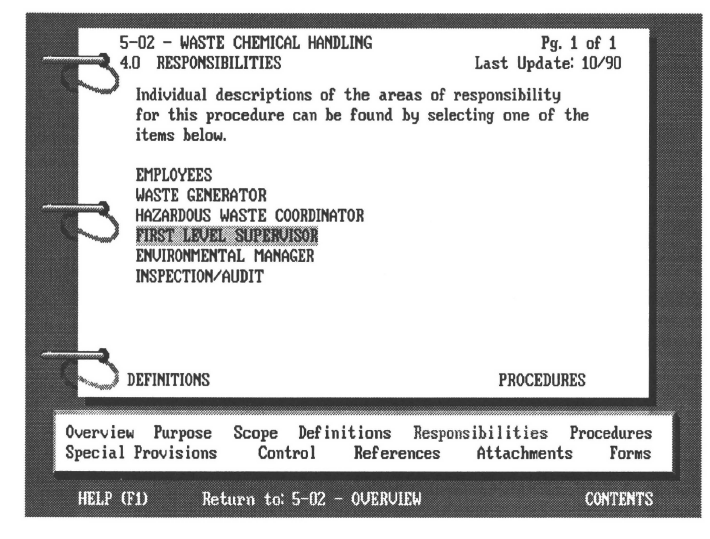
Source: Cognetics Corp.
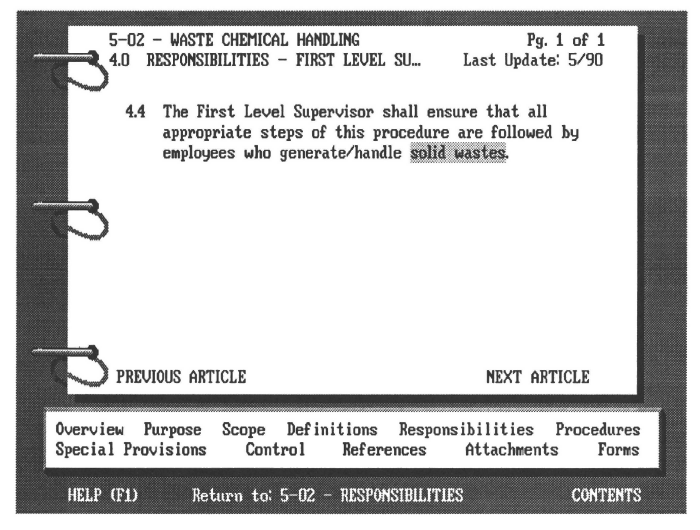
Cognetics Corp.

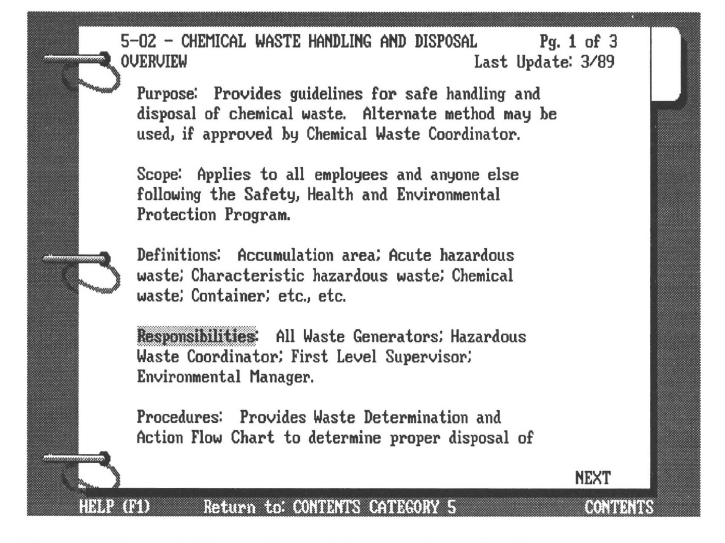
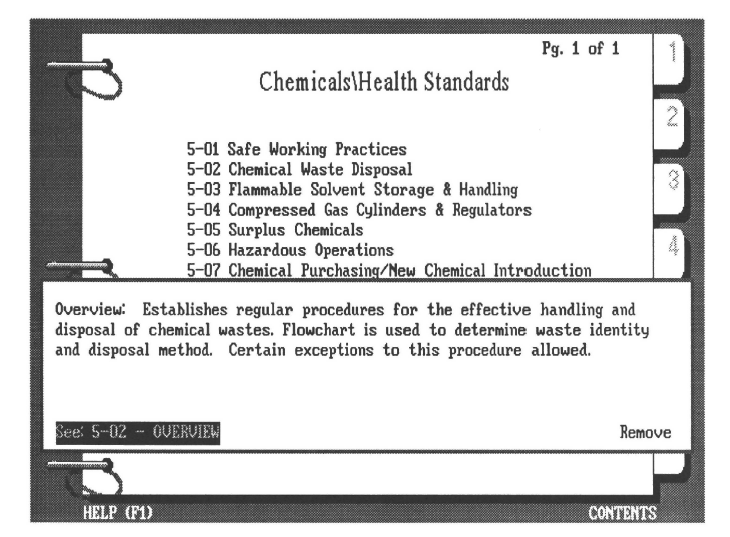
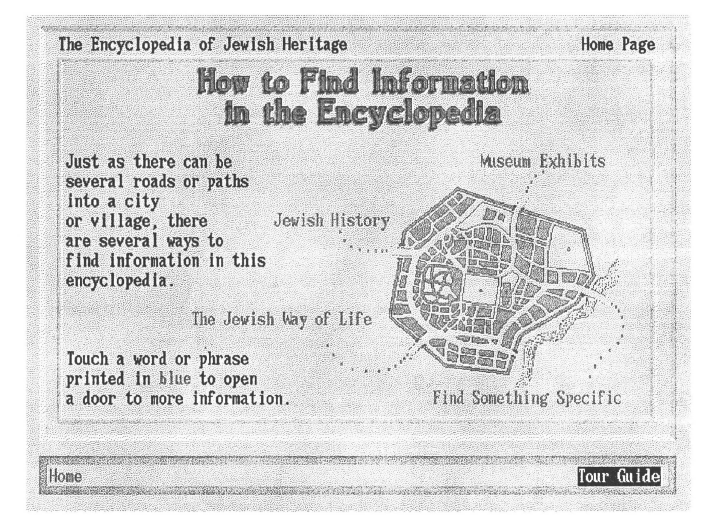
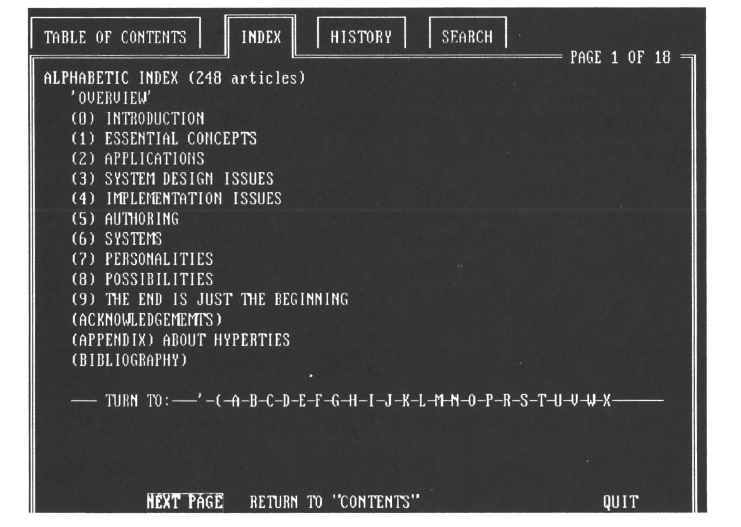
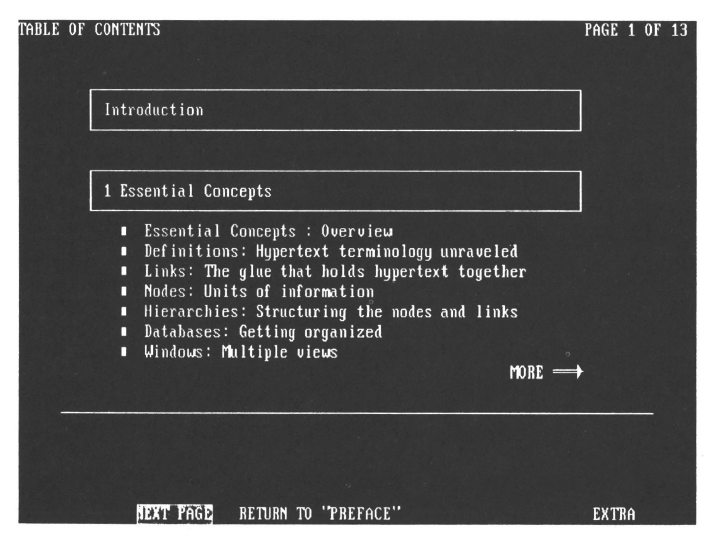
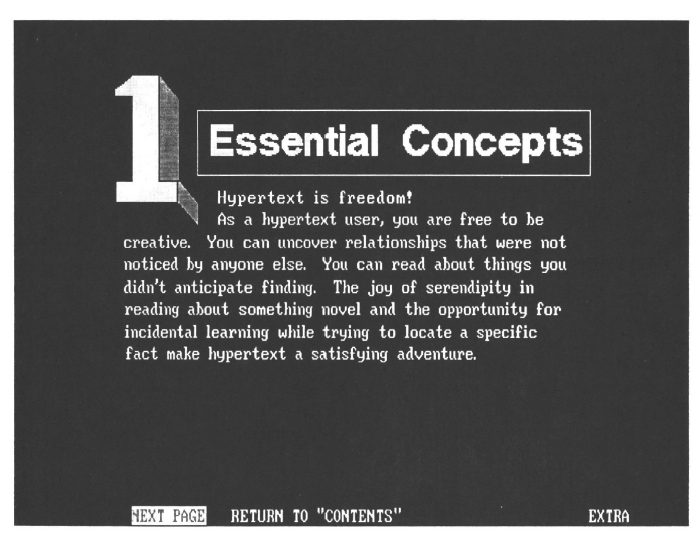
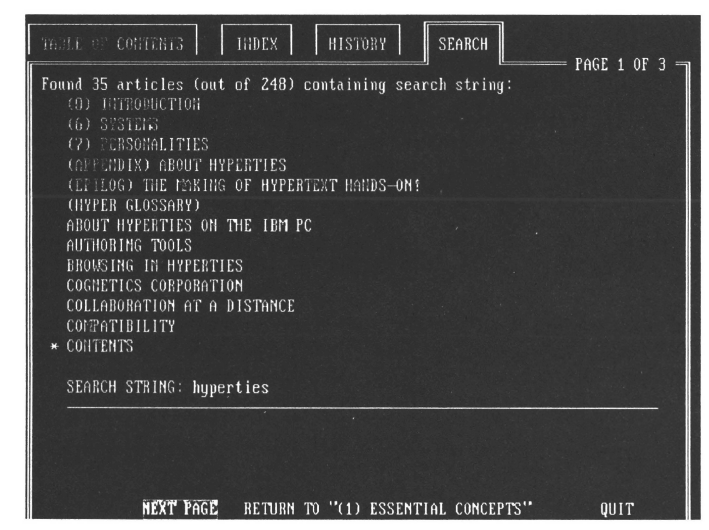
articles.
Footnotes
- Hyperties is a registered trademark of the Cognetics Corporation. ↵
About the Authors
Ben Shneiderman
Ben Shneiderman is a professor in the Department of Computer Science, head of the Human-Computer Interaction Laboratory, and member of the Institute for Advanced Computer Studies, all at the University of Maryland at College Park. He taught previously at the State University of New York and at Indiana University. He regularly teaches popular short courses and organizes an annual satellite television presentation on User Interface Strategies seen by thousands of professionals.Dr. Shneiderman is the author of Software Psychology: Human factors in Computer and Information Systems (1980) and Designing the User Interface: Strategies for Effective Human-Computer Interaction (1987), Addison-Wesley Publishers, Reading, MA. His most recent book, co-authored with Greg Kearsley, Hypertext Hands-On!, includes a hypertext version on two disks. He is the originator of the Hyperties hypermedia system, now produced by Cognetics Corp., Princeton Junction, NJ. In addition, he has co-authored two textbooks, edited three technical books, and published more than 120 technical papers and book chapters.
Ben Shneiderman is on the Editorial Advisory Board of the International Journal of Man-Machine Studies, Interacting with Computers, Behaviour and Information Technology, International Journal of Human-Computer Interaction and Human-Computer Interaction Abstracts. He edits the Ablex Publishing Co. book series on Human-Computer Interaction. He has consulted and lectured for many organizations including Apple, AT&T, Citicorp, GE, Honeywell, IBM, Library of Congress, NASA, and University research groups.Dr. Shneiderman may be contacted at the Human-Computer Interaction Lab., Dept. of Computer Science, University of Maryland, College Park, MD, 20742.
Charles Kreitzberg
Charles B. Kreitzberg is President of Cognetics Corporation, which specializes in the design of human-centered software products. One of the software products distributed by Cognetics is Hyperties. Dr. Kreitzberg has assisted in the design of automatic bank terminals, museum exhibits, videotext, and hypertext systems and educational software.Before he founded Cognetics Corporation, Dr. Kreitzberg was the director of technology research and development at the Educational Testing Service. He co-authored four books and many articles.
Dr. Kreitzberg also developed a computerized SAT study disk for Harcourt, Brace, and Jovanovich; an interactive novel, Amnesia, which was published by Electronic Arts; a software series to help young children develop problem-solving skills, interactive advertising, computer-based testing and measurement software, and other successful software packages.Dr. Kreitzberg received his B.A. in computing in 1969 from City College of New York, an M.S. in computer science from Rutgers University (1972), and his Ph.D. in educational psychology from the City University of New York (1978). He is a licensed psychologist in New Jersey and New York. He may be reached at Cognetics Corporation, 55 Princeton-Hightstown Road, Princeton Junction, NJ 08540.
Emily Berk
Emily Berk is co-editor of this handbook. She has been a designer and programmer of interactive hyper- and multimedia since 1980. Some of her recent multimedia meanderings have taken her to work as Project Leader on the DVI-based Words in the Neighborhood application at RCA Sarnoff Labs and as chief instigator of the Zoo Project, a HyperCard-based mapping program.References
Aho, A.A., Kernighan, B.W., and Weinberger, P.J., (1988). The AWK Programming Language, Addison-Wesley, Reading, MA.
Big Science Company, (1990). SmarText Command Language Application Notes, Release 1.0, Atlanta, GA.
Bryan, M., (1988). SGML: An Author's Guide to the Standard Generalized Markup Language, Addison-Wesley, Reading, MA.
Conklin, J. (1978). "Hypertext: An Introduction and Survey," Computer, Sept., 1978, 17-41.
Foltz, P.W. (1990). "Using Latent Semantic Indexing for Information Filtering", Conf. on Office Information Systems, Cambridge, MA, 150-157.
Furnas, G.W., Landauer, T.K., Gomez, L.M., Dumais, S.T. (1983). "Statistical Semantics: Analysis of the Potential Performance of Keyword Information Systems," Bell System Technical Journal 62(6), 1753-1806.
Goldfarb, C. F. (Ed.), (1986). "Information Processing-Text and Office Systems-Standard Generalized Markup Language (SGML)," Int'l Standard ISO 8879. Int'l Organization for Standardization, Geneva.
Salton, G. (1989a). Automatic Text Processing: The Transformation, Analysis, and Retrieval of Information by Computer, Addison-Wesley, Reading, MA.
Salton, G. (1989b). "On the Application of Syntactic Methodologies in Automatic Text Analysis", Proceedings of 12th Int'l ACMSIGIR Conf. on Research and Development in Info. Retrieval, Cambridge, MA, June, 1989, 137-150.
Shneiderman, B. (1983). "Direct Manipulation: A Step Beyond Programming Languages," Computer, August 1983,57-69.
Shneiderman, B., Kreitzberg, C., Berk, E. (1991). "Editing to Structure a Reader's Experience," in Hypertext/Hypermedia Handbook, Emily Berk and Joseph Devlin (Eds), McGraw-Hill, New York, NY.